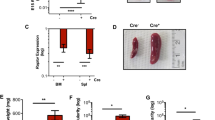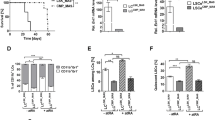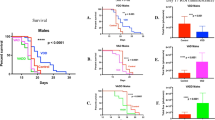Abstract
The role/s of retinoids in granulopoiesis has been recognised for many years, being powerful differentiation inducers. The physiological role/s of retinoic acid receptor (RAR)-mediated signalling during adult haemopoiesis has by contrast proved more elusive. The recent generation of highly specific pan-RAR antagonists has now made possible an assessment of the specific physiological role/s of RAR signalling, allowing the separation for the first time of the RAR and RXR pathways. Mice were treated with AGN194310, a synthetic retinoid that antagonises the physiological function of the three RAR isotypes (α, β, γ) but does not interact with RXRs. Analyses of the granulocytic lineage using Gr-1, c-Kit and CD11b antibodies, demonstrated that granulocyte numbers were strikingly increased across haemopoietic compartments in all AGN194310-treated mice. A significant increase in the frequency of progenitor cells containing granulocytes was observed in the bone marrow of mice following treatment with AGN194310. In contrast we were not able to detect any differences in cell death of either mature granulocytes or granulocytic progenitors from AGN194310-treated mice compared with control animals. These data demonstrate an essential role for RAR signalling in regulating the numbers of granulocytic precursors in vivo.
This is a preview of subscription content, access via your institution
Access options
Subscribe to this journal
Receive 12 print issues and online access
$259.00 per year
only $21.58 per issue
Buy this article
- Purchase on Springer Link
- Instant access to full article PDF
Prices may be subject to local taxes which are calculated during checkout







Similar content being viewed by others
References
Evans RM . The steroid and thyroid hormone receptor superfamily Science 1988 240: 889–895
Chambon P . A decade of molecular biology of retinoic acid receptors Faseb J 1996 10: 940–954
Chen JD, Evans RM . A transcriptional co-repressor that interacts with nuclear hormone receptors Nature 1995 377: 454–457
Chen H, Lin RJ, Schiltz RL, Chakravarti D, Nash A, Nagy L, Privalsky ML, Nakatani Y, Evans RM . Nuclear receptor coactivator ACTR is a novel histone acetyltransferase and forms a multimeric activation complex with P/CAF and CBP/p300 Cell 1997 90: 569–580
Onate SA, Tsai SY, Tsai MJ, O'Malley BW . Sequence and characterization of a coactivator for the steroid hormone receptor superfamily Science 1995 270: 1354–1357
Torchia J, Rose DW, Inostroza J, Kamei Y, Westin S, Glass CK, Rosenfeld MG . The transcriptional co-activator p/CIP binds CBP and mediates nuclear–receptor function Nature 1997 387: 677–684
Labrecque J, Allan D, Chambon P, Iscove NN, Lohnes D, Hoang T . Impaired granulocytic differentiation in vitro in hematopoietic cells lacking retinoic acid receptors alpha1 and gamma Blood 1998 92: 607–615
Tsai S, Collins SJ . A dominant negative retinoic acid receptor blocks neutrophil differentiation at the promyelocyte stage Proc Natl Acad Sci USA 1993 90: 7153–7157
Tsai S, Bartelmez S, Sitnicka E, Collins S . Lymphohematopoietic progenitors immortalized by a retroviral vector harboring a dominant-negative retinoic acid receptor can recapitulate lymphoid, myeloid, and erythroid development Genes Dev 1994 8: 2831–2841
Du C, Redner RL, Cooke MP, Lavau C . Overexpression of wild-type retinoic acid receptor alpha (RARalpha) recapitulates retinoic acid-sensitive transformation of primary myeloid progenitors by acute promyelocytic leukemia RARalpha-fusion genes Blood 1999 94: 793–802
Tocci A, Parolini I, Gabbianelli M, Testa U, Luchetti L, Samoggia P, Masella B, Russo G, Valtieri M, Peschle C . Dual action of retinoic acid on human embryonic/fetal hematopoiesis: blockadeof primitive progenitor proliferation and shift from multipotent/erythroid/monocytic to granulocytic differentiation program Blood 1996 88: 2878–2888
Labbaye C, Valtieri M, Testa U, Giampaolo A, Meccia E, Sterpetti P, Parolini I, Pelosi E, Bulgarini D, Cayre YE . Retinoic acid downmodulates erythroid differentiation and GATA1 expression in purified adult-progenitor culture Blood 1994 83: 651–656
Lohnes D, Mark M, Mendelsohn C, Dolle P, Dierich A, Gorry P, Gansmuller A, Chambon P . Function of the retinoic acid receptors (RARs) during development (I). Craniofacial and skeletal abnormalities in RAR double mutants Development 1994 120: 2723–2748
Mendelsohn C, Lohnes D, Decimo D, Lufkin T, LeMeur M, Chambon P, Mark M . Function of the retinoic acid receptors (RARs) during development (II). Multiple abnormalities at various stages of organogenesis in RAR double mutants Development 1994 120: 2749–2771
Bavik C, Ward SJ, Chambon P . Developmental abnormalities in cultured mouse embryos deprived of retinoic by inhibition of yolk-sac retinol binding protein synthesis Proc Natl Acad Sci USA 1996 93: 3110–3114
Lufkin T, Lohnes D, Mark M, Dierich A, Gorry P, Gaub MP, LeMeur M, Chambon P . High postnatal lethality and testis degeneration in retinoic acid receptor alpha mutant mice Proc Natl Acad Sci USA 1993 90: 7225–7229
Kuwata T, Wang IM, Tamura T, Ponnamperuma RM, Levine R, Holmes KL, Morse HC, De Luca LM, Ozato K . Vitamin A deficiency in mice causes a systemic expansion of myeloid cells Blood 2000 95: 3349–3356
Nauss KM, Mark DA, Suskind RM . The effect of vitamin A deficiency on the in vitro cellular immune response of rats J Nutr 1979 109: 1815–1823
Kochhar DM, Jiang H, Penner JD, Johnson AT, Chandraratna RA . The use of a retinoid receptor antagonist in a new model to study vitamin A-dependent developmental events Int J Dev Biol 1998 42: 601–608
Agarwal C, Chandraratna RA, Johnson AT, Rorke EA, Eckert RL . AGN193109 is a highly effective antagonist of retinoid action in human ectocervical epithelial cells J Biol Chem 1996 271: 12209–12212
Lee MO, Dawson MI, Picard N, Hobbs PD, Pfahl M . A novel class of retinoid antagonists and their mechanism of action J Biol Chem 1996 271: 11897–11903
Thacher SM, Nagpal S, Klein ES, Arefieg T, Krasinski G, DiSepio D, Agarwal C, Johnson A, Eckert RL, Chandraratna RA . Cell type and gene-specific activity of the retinoid inverse agonist AGN 193109: divergent effects from agonist at retinoic acid receptor gamma in human keratinocytes Cell Growth Differ 1999 10: 255–262
Johnson AT, Wang L, Standeven AM, Escobar M, Chandraratna RA . Synthesis and biological activity of high-affinity retinoic acid receptor antagonists Bioorg Med Chem 1999 7: 1321–1338
Purton LE, Bernstein ID, Collins SJ . All-trans retinoic acid enhances the long-term repopulating activity of cultured hematopoietic stem cells Blood 2000 95: 470–477
Karasuyama H, Melchers F . Establishment of mouse cell lines which constitutively secrete large quantities of interleukin 2, 3, 4 or 5, using modified cDNA expression vectors Eur J Immunol 1988 18: 97–104
Meco D, Scarpa S, Napolitano M, Maroder M, Bellavia D, De Maria R, Ragano-Caracciolo M, Frati L, Modesti A, Gulino A . Modulation of fibronectin and thymic stromal cell-dependent thymocyte maturation by retinoic acid J Immunol 1994 153: 73–83
Szondy Z, Reichert U, Fesus L . Retinoic acids regulate apoptosis of T lymphocytes through an interplay between RAR and RXR receptors Cell Death Differ 1998 5: 4–10
Kastner P, Lawrence HJ, Waltzinger C, Ghyselinck NB, Chambon P, Chan S . Positive and negative regulation of granulopoiesis by endogenous RARalpha Blood 2001 97: 1314–1320
Acknowledgements
CRW is a recipient of an Australian Postgraduate Award and GAM is a Special Fellow of the Leukaemia and Lymphoma Society. This work was supported by a grant from the National Health and Medical Research Council of Australia to GAM. The authors gratefully acknowledge Drs L Purton, G Poortinga, JP Levesque and P Humbert for helpful discussion and critical comments. We thank Dr S Collins for the BHK-SCF cell line, PMCI Animal Facility staff for care of experimental animals and A Fryga for technical assistance with FACS sorting.
Author information
Authors and Affiliations
Rights and permissions
About this article
Cite this article
Walkley, C., Yuan, YD., Chandraratna, R. et al. Retinoic acid receptor antagonism in vivo expands the numbers of precursor cells during granulopoiesis. Leukemia 16, 1763–1772 (2002). https://doi.org/10.1038/sj.leu.2402625
Received:
Accepted:
Published:
Issue Date:
DOI: https://doi.org/10.1038/sj.leu.2402625
Keywords
This article is cited by
-
The immunomodulatory role of all-trans retinoic acid in tumor microenvironment
Clinical and Experimental Medicine (2022)
-
Extrinsic Regulation of Hematopoietic Stem Cells and Lymphocytes by Vitamin A
Current Stem Cell Reports (2018)
-
Antagonizing Retinoic Acid Receptors Increases Myeloid Cell Production by Cultured Human Hematopoietic Stem Cells
Archivum Immunologiae et Therapiae Experimentalis (2017)
-
Epidermal phospholipase Cδ1 regulates granulocyte counts and systemic interleukin-17 levels in mice
Nature Communications (2012)
-
Myeloid-derived suppressor cells as regulators of the immune system
Nature Reviews Immunology (2009)



